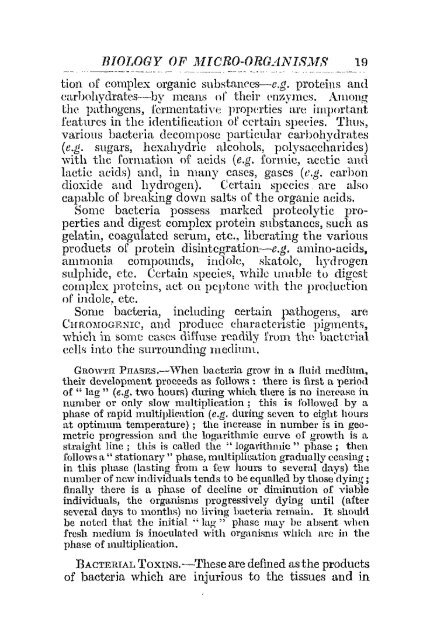AGf~ICULTURAL RESEARCH, PUSA.
AGf~ICULTURAL RESEARCH, PUSA.
AGf~ICULTURAL RESEARCH, PUSA.
You also want an ePaper? Increase the reach of your titles
YUMPU automatically turns print PDFs into web optimized ePapers that Google loves.
BIOLOGY OF MICRO-ORGANIS,J.Y[S 19<br />
tion of complex organic suhstanccs--e.g. proteins and<br />
earhohydl'ates---by means or t.heir enzymes. Among<br />
the pathogens, fermentatin: proptrties are important<br />
features in the identification of ecrtain spceiC's. Thus,<br />
various bacteria decompose particular carbohydrates<br />
(e.g. sugars, hexahydric alcohols, polysa.ccharides)<br />
with the formation of acids (e.g. formic, aeetic and<br />
lactic aeids) and, in many cases, gases (e.g. eurbon<br />
dioxide and hydrogen). Certain species are also<br />
capable of breaking down salts or the organic adds.<br />
Some bacteria possess marked proteolytic properties<br />
and digest complex protein substances, such as<br />
gelatin, coagulated serum, etc., liberating the various<br />
products of protein disintegration-e.g. amino-acids,<br />
ammonia compounds, indole, skatole, hydrogen<br />
sulphide, etc. Certain species, while unable to digest<br />
complex proteins, net. on peptone with the procluetion<br />
of indole, etc.<br />
Some bacteria, including certain pathogens, are<br />
CHROMOGENIC, und produce characterist.ic pigments,<br />
which in some cases diffuse readily from the haeterial<br />
cclIi'> into the surrounding mediunt.<br />
GUOWTU PIIAsEs.-'iVhen bacteria grow in it Huia medium,<br />
their development proceeds as follows: there is rust a perio!l<br />
of" hlg " (e.g. two hours) during which there is no illme:.I.Re in<br />
number or only slow multiplication; this is followed by a<br />
phase of rapid llluitiplic:ttion (e.g. during sevell to eight honrs<br />
at optimum temperature); the increase in number is in geometric<br />
progression and the logarithmic curve of growth is a<br />
straight line; this is called the "logarithmic" phase; then<br />
follows :t " stationary" phase, mllltiplieatiou gradually ceasing;<br />
ill this phase (lasting from a few hours to several days) the<br />
number of' new individuals tends to be equalled by those dying;<br />
finally there is a phase of deeliue or diminution of vinhle<br />
individuals, the organisms progressively dying until (after<br />
seventl days to months) no Jiying bacterin remain. It shonlrl<br />
be noted that the initial "lag" phase may be absent whell<br />
fresh medium is illoeulatrd with organisms 'which nrc in the<br />
phase of multiplication.<br />
BACTERIAL TOXINs.-Theseare defined as the products<br />
of bacteria which are injurious to the tissues and in

















